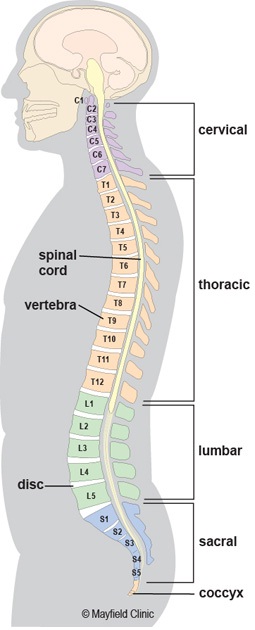by Alan Jordan
An illustration of the entire spinal column can be seen below.
The spinal column is easily recognisable and is built up of vertebrae (bone) which are separated by discs (cartilage). The joints of the spine are at the rear and most of the muscles attach to the rear area.
Pain Giving Structures
Injury to the vertebrae themselves, the discs, the muscles, the ligaments, the attaching tendons, the joint capsules, the vessels and nerves can ALL result in pain. To complicate matters further, injury almost always involves several of these tissues rendering it almost impossible to accurately diagnose which individual tissue is the culprit.
What About Diagnostic Imaging?
Although the discovery of x-rays, CT and MRI scans have been landmark discoveries in the diagnosis and treatment of spinal pain it is only in a minority of patients – 15-20% – in which findings based upon imaging can accurately point to the tissue involved. These cases are usually of a more serious nature and include frank disc prolapses, tumours, infections and other inflammatory conditions. For most patients, imaging is undertaken in order to ensure that none of these conditions are present. That is of course most useful, but does not lead to a firm conclusion.
Non Specific Back Pain
The most common diagnosis for lower back pain is non-specific lower back pain. As the name indicates, it is a pleasant way of saying that we simply don’t know what the pain giving tissue is.
That does not mean that we are unsure as to which treatment to use, but treatment results would be much enhanced if we could diagnose with a greater degree of accuracy.
This is also the main reason why some patients respond well to manipulation or exercise for example, while others do not. The same applies to acupuncture or other commonly used treatments.
Working Diagnosis
The proper way to monitor whether your treatment is appropriate for a given patient is to firstly determine whether or not they are suited to your form of treatment. If expected progress is not achieved within a predetermined time frame (7-10 days) patients should be referred to another practitioner or chiropractor. That is why we have such a broad array of health disciplines at our clinic. In fact, at Broadgate, we provide each and every form of therapy that the National Institute for Clinical Excellence recommends, including occupational therapy.
Additionally, we have an array of Medical Consultants on staff including rheumatology, spinal surgery, sports medicine and neurology if additional investigations and/or second opinions are required.
We are proud of the service that we are able to provide in one setting. Patients are provided with expert care and are fast-tracked to other care as appropriate.





